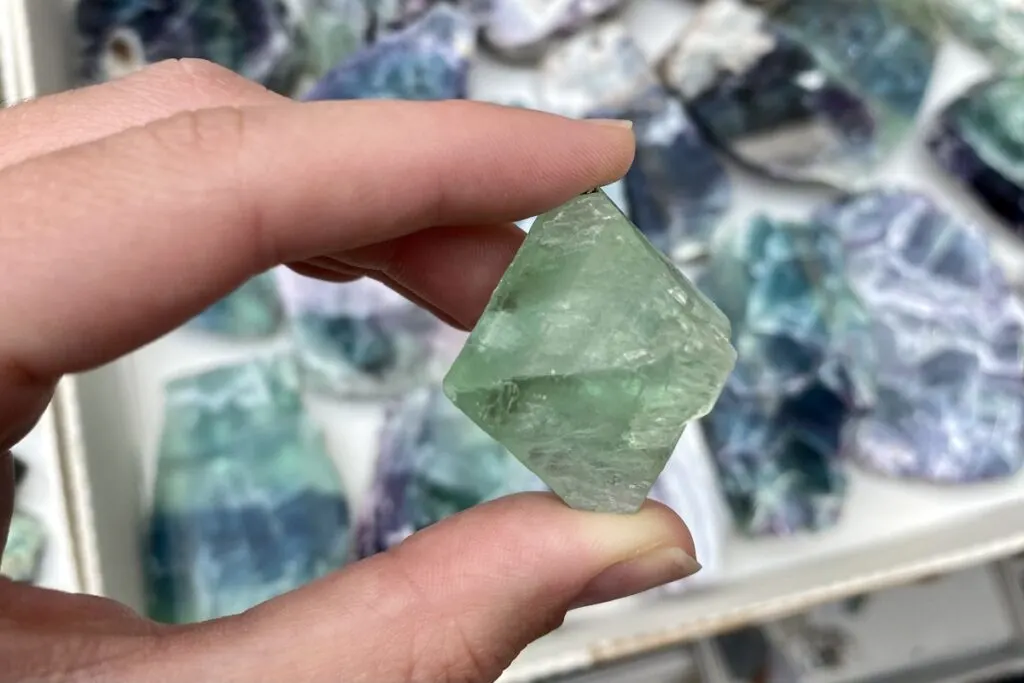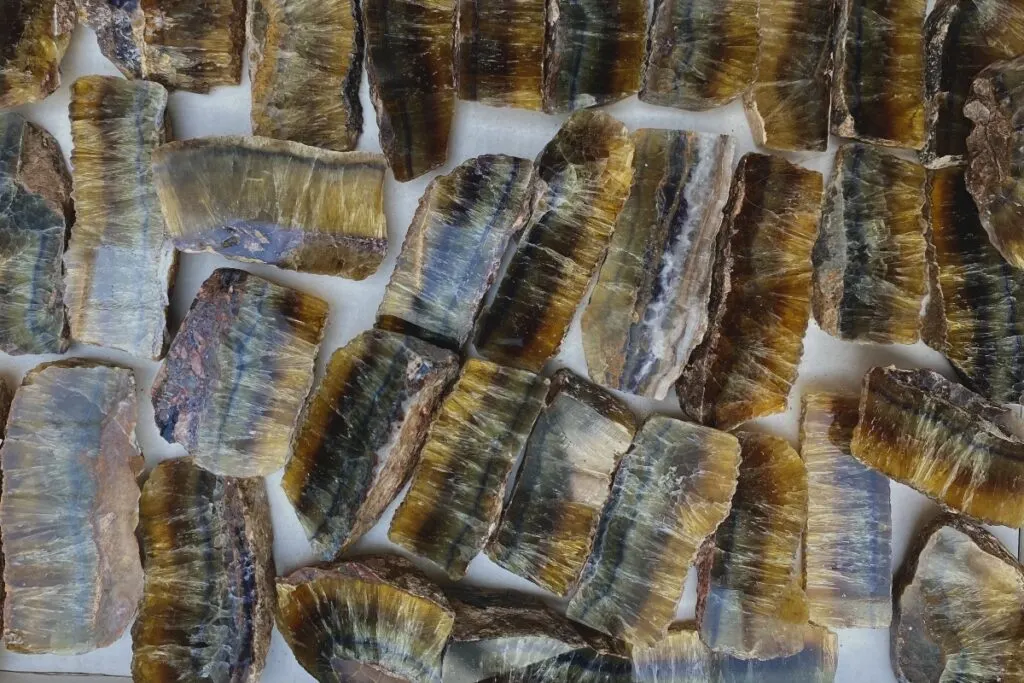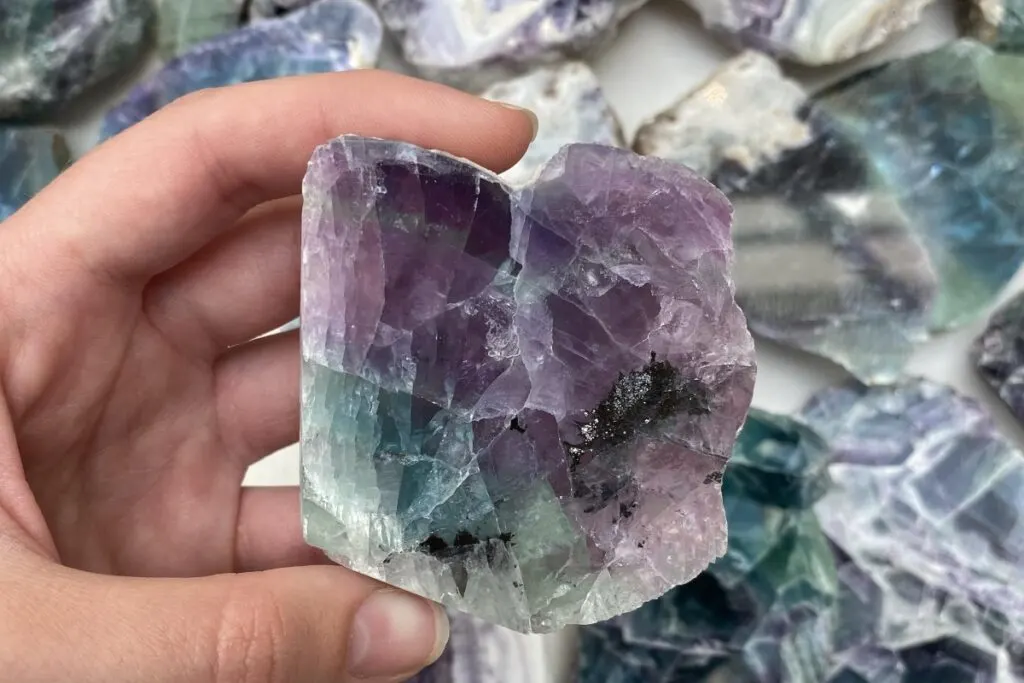As an Amazon Associate, I earn from qualifying purchases with no additional costs for you.
Fluorite can be extremely valuable because of these main factors: color, zonality, crystal habit, mineral paragenesis, and clarity. In addition, Fluorite is a widespread mineral easily accessible at good quality and affordable prices. However, some fluorite species can reach thousands of dollars in cost.
The most valuable fluorite has saturated colors (pink, purple, blue, green). Fluorites with unique physical properties like alexandrite (color-change) effect, strong fluorescence, or color zoning within one crystal are considered the most valuable. Fluorite from particular localities has a higher value.
Did you know that fluorite can have a color-change effect, similar to alexandrite, and can be faceted into palm size brilliant gemstones? We used to see fluorite-like hazy violet-greem small octahedrons or cubes on mineral shows.
That’s true that common fluorite is not so valuable; however, some species can blow your mind. Further, we will list the main factors of fluorite value and provide a list of price ranges for different fluorite varieties in other units.

If you want to check out the best rockhounding tools, you can find them by clicking here (Amazon link).
Is Fluorite Worth Anything
Fluorite (CaF2) is a remarkable mineral as it covers all aspects in which the mineral can be used. First, fluorite is a beautiful mineral and gemstone that occurs in an extensive palette of colors and is available in relatively bigger sizes than other gems.
Second, fluorite can be used as an ornamental stone for carving. Another appealing aspect of fluorite is that it typically occurs as translucent to utterly limpid crystals allowing it to be faceted into huge transparent gemstones.
Fluorite prices range dramatically from several cents for a piece to ten thousand USD for cabinet mineral species. Because fluorite occurs in a rainbow of colors and transparency, it can meet any requirement. This makes fluorite a universal mineral that is definitely worth something.
Fluorite is widely used without any enhancement process as a natural mineral specimen. Vivid color combinations and big sizes make it perfect as cabinet species and museums highlight.
Additionally, fluorite is a mineral resource pivotal in optics, metallurgy, electronics, and chemical industries. Furthermore, fluorite has remarkable optical properties like fluorescence, phosphorescence, thermoluminescence, and a color-changing (alexandrite) effect.
How Much Is Fluorite Worth

Fluorite gemstone prices range from a few cents per carat for lower-grade specimens to $30 – 40 per carat for high-quality or rare stones.
Fluorite mineral samples are worth a few dollars for 3 – 5 cm species and up to tens of thousands of dollars for cabinet species (20 x 15 cm) of the best quality.
TIP: Fluorite is one of the most widespread minerals in crystal collections. Hoverer, even an abundance of real fluorite cannot protect mineral collectors from fake. Find out more in the article below:
Real vs. Fake Fluorite: Focus on These 5 Differences
Why is Fluorite So Expensive? Main Factors
The main factors of fluorite value are color, clarity, size, origin, crystal shape, mineral associations, and carving craftsmanship.
Vivid blue and pink colors, rainbow color combinations, transparency, origin from particular localities, and various optical effects make fluorite more expensive.
Color
The main quality factor, like for any other mineral, is color. Fluorite is known for its wide range of colors, including purple, blue, green, yellow, and more.
The most significant advantage of fluorite is that colors are typically very intense and deep. Ink-blue without grayish and brownish admixtures, intense fuchsia, vivid pinkish-purplish-red, and mint green are among the most valuable colors of fluorite.
Clarity
High-quality fluorite specimens should have excellent clarity and luster to fetch higher prices.
Color zoning

Fluorite can combine various colors in one crystal, sometimes producing a colorful rainbow variety. Specimens with visually striking patterns and distinct zoning are considered more valuable.
For example, Derbyshire, England’s Blue John fluorite, occurs in repetitive purple-blue and yellowish color-banded patterns and is highly praised for carving.
Size
Fluorite crystals are generally available in relatively bigger sizes than the bulk of other minerals and gemstones. Individual fluorite crystals can reach up to 30 cm. The combination of high clarity and considerable sizes of fluorite crystals allows producing jumbo-size faceted gemstones.
Crystal shape
Fluorite crystallizes in cubic and octahedron crystal shapes. Crystal twinning is common and adds complexity and beauty to the observed crystal habits. Perfectly crystallized specimens are an object of mineral collectors’ interest.
Mineral association
Fluorite paragenesis (co-occurrence) with other minerals can add value to a mineral sample. For example, fluorite can associate with rhodochrosite, calcite, dolomite, pyrite, quartz, aquamarine, and mica.
Origin
Certain regions where fluorite is found can produce higher-quality crystals than others. Some of these regions may also have historical significance.
For example, samples from Sweet Home Mine (Colorado), Minerva No. 1 Mine (Illinois), Elmwood Mine (Tennesse), and Deer Trail Mine (Utah) are considered the most valuable from the United States.
Astonishing fluorites come from Hunan Province and Inner Mongolia from China. Some fascinating species originate from Goschenen Valley, Switzerland, and northern Mexico.
Optical phenomena

Some mineral collectors specialize exceptionally in fluorescent minerals, and fluorite is one of the main pieces of their interest. Fluorite can glow in blue, yellow, red, and other colors under UV. The glow colors are very intense and saturated.
Some other optical phenomena reported from fluorite are the color-change effect (similar to alexandrite) and sometimes thermoluminescence (the process in which a mineral emits light while it is being heated).
Combining the most valuable parameters can make some fluorite mineral specimens and faceted stones extremely valuable and expensive.
TIP: Many minerals have the ability to fluoresce. They glow when observed under ultraviolet (UV) light. Find out more in the article below:
GUIDE: Rockhounding with UV Light & 3 Best UV Lights (2022)
BTW: If you are looking for the best UV light for rockhounding, find out my picks below (Amazon links):
- BEST OPTION: Convoy 8+ 365nm UV LED Flashlight with Patented Glass Filter
- BUDGET OPTION: Karrong Rechargeable 1200 Lumen 395nm UV Flashlight
- OPTION FOR INDOOR USAGE: Prime Upgraded Big Chip 396nm UV
Fluorite Price per Pound, Ounce, Gram, Kg & Carat
Fluorite price varies dramatically depending on the combination of quality factors and whether the stone is in its natural mineral state or faceted. The fluorite price per carat varies from $0.06 to 0.12 for rough and $3-30 for cut stone. Crystals cost $0.3-0.6 per gram, and gems $15-$150 per gram.
Here you can see a table of fluorite prices for different weight units. Pay attention that price varies dramatically whether fluorite is in a rough state or faceted.
| Weight units | Fluorite price for faceted gemstones | Fluorite price for rough crystals |
|---|---|---|
| per carat (ct) | $3 – $30 | $0.06 – 0.12** |
| per gram (g) | $15 – $150* | $0.30 – 0.60 |
| per ounce (oz) | $420 – $4,200* | $8.40 – 16.80** |
| per pound (Ib) | $6,795 – $67,950* | $135.90 – 7,610** |
| per kilo (kg) | $15,000 – $150,000* | $8,400 – 16,800** |
* – recalculated based on the price per carat
** – recalculated based on the price per gram
Fluorite Price by Color

Fluorite price depends on the color mineral. Common pale green and purple fluorite costs around $0.3 – 0.6 per gram. Blue and vivid purple varieties of fluorite command higher prices, $1 – 5 per gram. The price for rainbow fluorite is typically higher, up to $7 per gram.
Here are approximate price ranges for different varieties of fluorite. Please note that these are general ranges and can vary depending on the value factors discussed above.
| Color of fluorite | Price range per gram |
|---|---|
| Green fluorite | $0.30 – $0.60 |
| Yellow fluorite | $0.30 – $0.60 |
| Purple fluorite | $1.00 – $5.00 |
| Blue fluorite | $1.00 – $5.00 |
| Rainbow fluorite | $1.00 – $7.00 |
BTW: Do you want to know more about rock and mineral identification? The books listed below are the best ones you can find on the internet (Amazon links):
- Smithsonian Handbooks: Rocks & Minerals
- Gemstone & Crystal Properties (Quick Study Home)
- Ultimate Explorer Field Guide: Rocks and Minerals (National Geographic Kids)
Where to Buy Real Fluorite
Good-quality fluorite is readily available in every marketplace. Fluorite is not commonly faked, so it is safe to buy even online. However, purchasing from specialized dealers for higher-quality mineral species is better.
You can buy good-quality real fluorite via online mineral and gemstone retailers like eBay and Etsy. However, it is always better to purchase fluorite at local mineral shows, where you can inspect a mineral sample. The best option is to buy real fluorite near the mines or to find your own during rockhounding.
If you want to find fluorite in the U.S., some of the best states to search for are Utah, New Mexico, Kentucky, Arizona, and New York.
TIP: You can find more information in the article:
Where to Find Fluorite: Best Environments & Locations (USA)
Conclusion
Fluorite is a widely spread mineral and readily available in different qualities. Being a widespread mineral doesn’t mean it is not valuable. Fluorite prices can reach tens of thousands of dollars for rare mineral specimens.
The main factors of fluorite value are:
- Color: blue, pink, green
- Clarity: flawless
- Color zoning: an appealing combination of colors
- Size: substantial
- Crystal shape: perfectly crystalized faces; cubes, octahedrons, twins
- Mineral association: paragenesis with calcite, dolomite, rhodochrosite
- Origin: USA, China, Switzerland, Mexico
- Optical phenomena: color-change effect, fluorescence, thermoluminescence
The most valuable species of fluorite has intense blue, purple, or green color, is eye-clean, and has visually appealing color zoning, with the substantial size of perfectly crystallized crystal faces.
Moreover, it can have other associated minerals arranged in an esthetically pleasing way that increases fluorite value either. Optical phenomena like the color-change effect, fluorescence, and thermoluminescence also increase fluorite value.
Prices for fluorite vary dramatically depending on the factors described above and the state of the sample, whether it is a rough crystal or faceted gemstone.
The fluorite price per carat varies from $0.06 to 0.12 for rough and $3-30 for cut stone. Rough crystals cost $0.3-0.6 per gram and gems $15-$150 per gram.
Depending on the color of fluorite, common pale green and purple fluorite costs around $0.3 – 0.6 per gram. Blue and vivid purple varieties of fluorite command higher prices, $1 – 5 per gram. The price for rainbow fluorite is typically higher, up to $7 per gram.
TIP: There is a stereotypical image of a geologist walking in the mountains with a hammer and a backpack full of stones. But this image is not so truthful. Find out more in the article below:
The Most Common Tools Geologists Use in Labs & on Field Works
